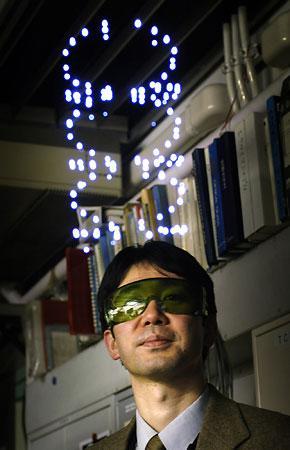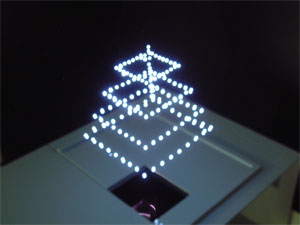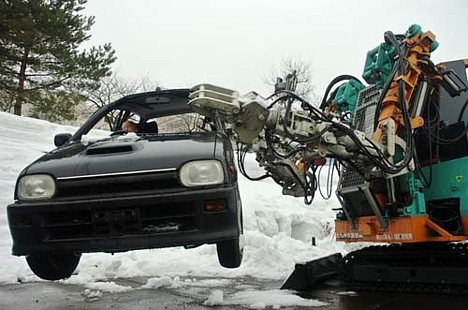 Japan's National Institute of Advanced Industrial Science and Technology (AIST) has developed a device that uses lasers to project real three-dimensional images in mid-air. The institute unveiled the device on February 7 in a demonstration that showed off the device's ability to project three-dimensional shapes of white light.
Japan's National Institute of Advanced Industrial Science and Technology (AIST) has developed a device that uses lasers to project real three-dimensional images in mid-air. The institute unveiled the device on February 7 in a demonstration that showed off the device's ability to project three-dimensional shapes of white light.
AIST developed the projector with the cooperation of Keio University and Burton Inc. (Kawasaki, Japan). Until now, projected three-dimensional imagery has been "artificial" -- optical illusions that appear 3D due to the parallax difference between the eyes of the observer. Prolonged viewing of this conventional sort of 3D imagery can cause physical discomfort.
The newly developed device, however, creates "real" 3D images by using laser light, which is focused through a lens at points in space above the device, to create plasma emissions from the nitrogen and oxygen in the air at the point of focus. Because plasma emission continues for a short period of time, the device is able to create 3D images by moving the point of focus.
 At the demonstration, bursts of laser light were emitted 100 times per second to form shapes in the air up to 50 cm above the device. Heat from the laser caused the air to expand, producing a crackling sound that resembled a series of tiny explosions.
At the demonstration, bursts of laser light were emitted 100 times per second to form shapes in the air up to 50 cm above the device. Heat from the laser caused the air to expand, producing a crackling sound that resembled a series of tiny explosions.
At the moment, the distance at which the device can project images is limited to between 2 and 3 meters. Improved laser technology will enable images to be projected at greater distances and with more color, so we may soon see 3D images floating above our city skylines.
The chief scientist at AIST?s Photonics Research Institute says, "We believe this technology may eventually be used in applications ranging from pyrotechnics to outdoor advertising."
[Sources: Mainichi Shimbun, AIST press release, Burton Inc.]
UPDATE 1: The English translation of the press release is here.
UPDATE 2 (Aug 16, 2007): New and improved 3D projector

 A daikon radish with a distinctly human shape is the talk of the town in Sasamicho, Wakayama prefecture.
A daikon radish with a distinctly human shape is the talk of the town in Sasamicho, Wakayama prefecture. A recycled hairstyling mannequin head has been called upon to keep crows away from a garbage collection point in Ube, Japan.
A recycled hairstyling mannequin head has been called upon to keep crows away from a garbage collection point in Ube, Japan.
